Rules Catalog
Once your event logs are collected and normalized by Sekoia.io, you probably want to leverage them to detect suspicious activity within your perimeter. Rules contain the detection logic that determines when Alerts should be created.
All rules are applied to your event stream in real-time, so that you can detect - and respond to - threats as fast as possible.
Please check the dedicated FAQ page related to detection rule strategy.
Detection Rule Types
Sekoia.io supports the following detection types:
- Sigma: signature rules using the Sigma detection language
- CTI: rules based on Indicators Of Compromise (IOCs) coming from a Threat Intelligence feed. These rules automatically detect thousands of known malicious indicators (such as domain names, URLs, IP addresses, etc.). A CTI rule "SEKOIA Intelligence Feed" is already built-in to detect malicious activity based on a list of indicators from Sekoia.io's own Intelligence feed, continuously updated by our Threat & Detection Research team
- Anomaly: univariate anomaly detection rules.
Rules Catalog
The Rules Catalog page can be used to list and manage all detection rules. Many filters are available and can be combined to easily find the rules you are looking for.
Tip
You can enable or disable rules one by one or all at once according to current filters.
Rules Attributes
Available Rules in the Catalog
The Rules Catalog lists all detection rules available to your organization:
| Rule Type | Description |
|---|---|
| Sekoia Verified Rules | Rules with the valid icon are verified ones. These rules are created by Sekoia.io's Threat & Detection Research team and come built-in. They are continuously updated to enhance detection quality and follow a rigorous process to minimize false positives. This process is detailed in our blogpost XDR detection engineering at scale: crafting detection rules for SecOps efficiency. This set includes more than 1000 rules designed to detect known threats, attack patterns, and more. |
| Your Rules (Custom) | Rules created by your team that are specifically tailored to your organization. |
| Integration Rules (Verified) | Detection rules designed to monitor and alert on suspicious activity from third-party security tools and platforms integrated with Sekoia.io. Maintained by the Integrations team, these rules are clearly marked with partner branding in the Rules Catalog to help users quickly identify and filter detections originating from external sources. |
Effort Level
All rules are assigned an effort level that increases from Elementary to Master based on two factors:
- The effort required to enable the rule
- The risk of false positives generated by the rule
Descriptions of Effort Levels:
-
Elementary: Requires no effort to enable and generates fewer alerts. These rules are designed to be effective while minimizing false positives.
-
Intermediate: Similar in effort to Elementary rules but may produce more alerts.
-
Advanced: May require more effort to enable and can generate frequent alerts depending on the IT environment configuration.
-
Master: May need specific configuration to activate and/or generate a high volume of alerts. These rules are designed to detect subtle signals and usually require customization based on the organization's IT context. They are intended for mature security operations.
Rule Lifecycle
Each detection rule progresses through a lifecycle that communicates its current status and maintenance plan. Understanding rule lifecycle states helps your security team stay informed about rule changes and maintain an up-to-date detection strategy.
Lifecycle States
Rules in the catalog can exist in one of three states:
| Status | Description | Key Details |
|---|---|---|
| Active | The rule is currently maintained and actively detecting threats. | - Continue to receive updates and improvements from rule maintainers - Generate alerts as configured in your detection environment - Are counted in your organization's verified rule coverage metrics |
| Scheduled for Deprecation | Rule owners have flagged a rule for future retirement due to obsolescence, replacement, or maintenance considerations. | - A "Valid until" date is displayed on the rule card and detailed view, indicating when the rule will transition to Deprecated status - A warning tag appears on the rule - Users subscribed to deprecation notifications receive an alert - The rule continues to generate alerts until the validity date is reached - Rule owners provide a deprecation reason |
| Deprecated | The validity date has been reached and the rule is no longer actively maintained. | - A prominent warning banner is displayed on the rule card and detailed view - The rule remains enabled unless you disable it - Users subscribed to deprecation notifications receive a final notification - The rule continues to generate alerts until manually disabled or auto-disabled in the catalog |
How to set deprecation
- Open a custom rule in the Rules Catalog
- Click the Edit button
- Add a Valid until date
- Add a Deprecation reason to communicate context to users (mandatory)
- Save changes — the status automatically changes to "Scheduled for deprecation"
Get notified when a rule is deprecated
Stay informed about rule lifecycle changes by configuring deprecation notifications:
- Navigate to the Rules Catalog page
- Click the Get Notified button in the top right corner
- Under Notifications, enable "Receive notifications when a rule is scheduled for deprecation" and "Receive notifications when a rule is deprecated"
- You will receive alerts whenever rule status changes occur for rules in your organization
Automatic Deprecation Handling
To streamline your security operations, Sekoia.io provides an option to automatically disable deprecated rules:
- Navigate to Rules Catalog Settings
- Enable "Automatically disable deprecated rules"
- When enabled, deprecated rules will be automatically disabled on their deprecation date
Tip
We recommend enabling automatic deprecation of Sekoia's own verified rules to maintain alignment with our latest detection strategies. However, you may want to manually review deprecated custom rules before they are automatically disabled to ensure no critical detections are lost.
Intake formats
Rules are associated with Intake formats that they are compatible with. Detection rules can be enabled when they have a compatible intake format configured that provide the necessary data to detect suspicious activites.
Select an intake format in the left panel to list rules compatible with the intake format.
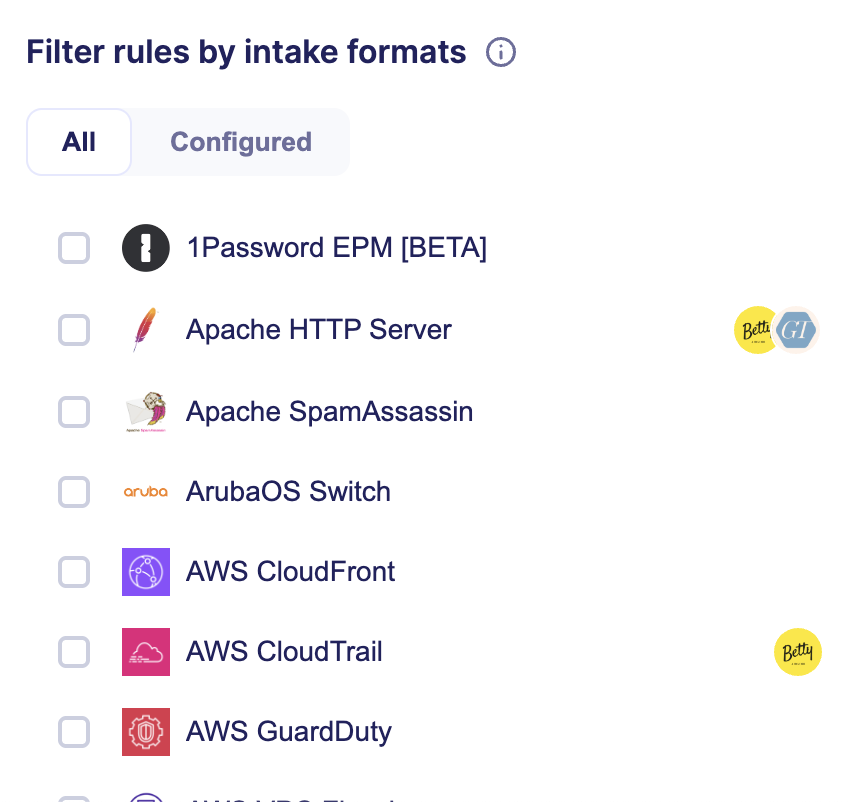
You can also filter by intake formats that you have already configured with the associated filter.
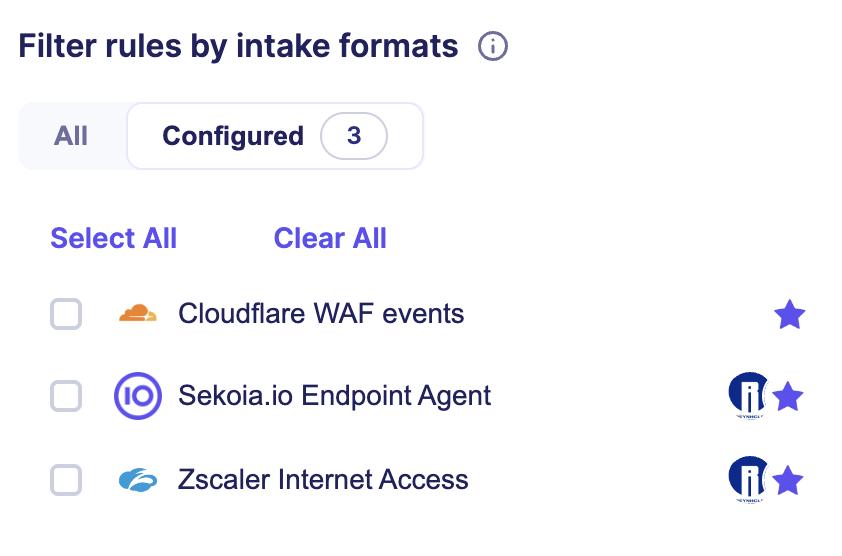
Threats
Rules are associated with Threats or Attack Pattern that they can detect.
Use the associated search filter to list rules associated to specific threats.
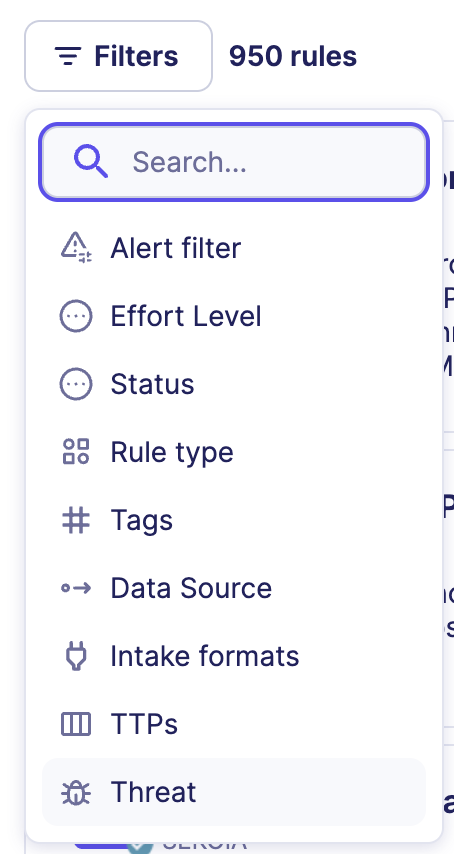
Tags
To have a filtered view of your rules, you can rely on filters cited before (Available/Verified, Effort level, Capabilities) but also on tags associated with rules.
These tags are defined by Sekoia.io analysts to help make searching for a rule easier and provide categories such as AWS, CVE, O365 and phishing.
To filter rules using tags, there are two ways:
- Select a tag under a rule and it will filter all rules to show only those with the same tag
- Click the filter button and select "Tags"
Security Profile (MITRE ATT&CK)
The MITRE ATT&CK framework is a comprehensive matrix of tactics and techniques used by threat hunters and defenders to better classify attacks and assess an organization's risk.
Whenever you filter the Rules Catalog, the matrix will update and rules will appear in blue on the matrix in one or many cells. Each cell represents an attack technique.
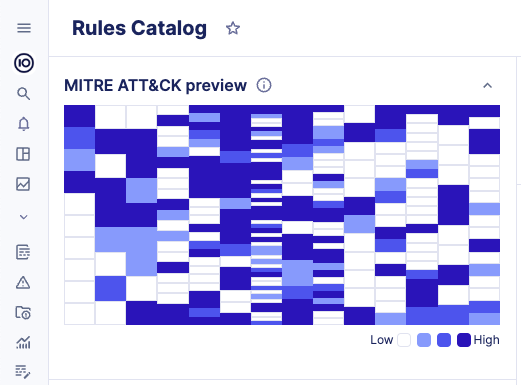
The color changes depending on the number of rules contained in one cell:
- Colored cells signify the presence of rules. Darker cells indicate a higher number of rules available for that specific technique. Lighter cells suggest that there are fewer enabled rules for the technique.
- A white cell means that no rule is available for that technique.
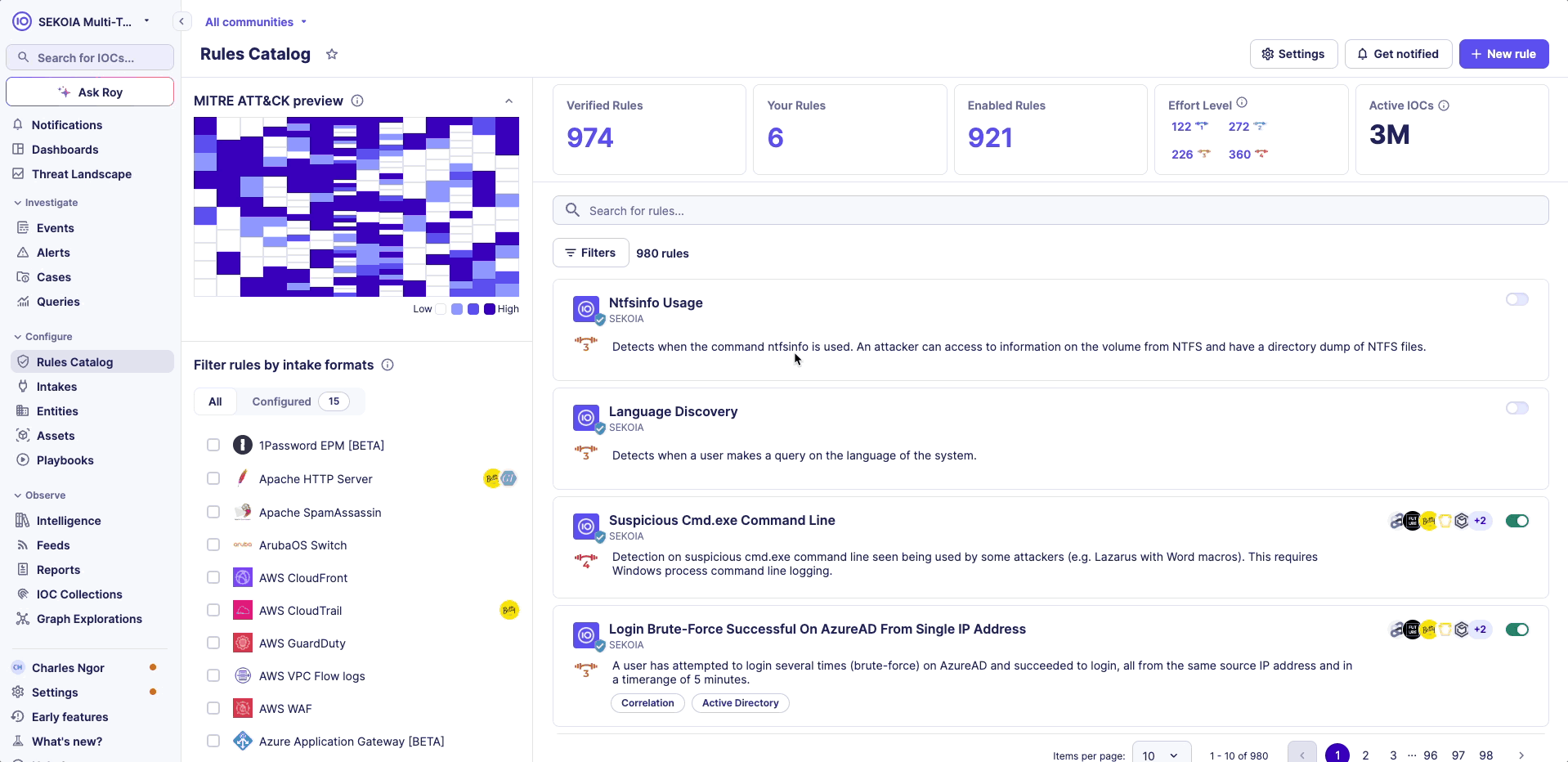
Click on the MITRE preview to explore the distribution of rules across each technique and sub-technique.
To view the MITRE framework in fullscreen, click the fullscreen button in the top-right corner of the modal.
Use the "Sub-techniques" button to expand or collapse all sub-techniques.
You can scroll through the MITRE details both horizontally and vertically.
Rule Details
You can click on the name of a rule to display additional details, such as, but not limited to:
- The severity which should be used to later determine the Alert's Urgency
- The validity date of the rule
- The category of created alerts
- Associated Threats
- Associated Data Sources
- Known False Positives
- The detection logic (the rule pattern)
- Alert filters
- Similarity strategy for the produced alerts
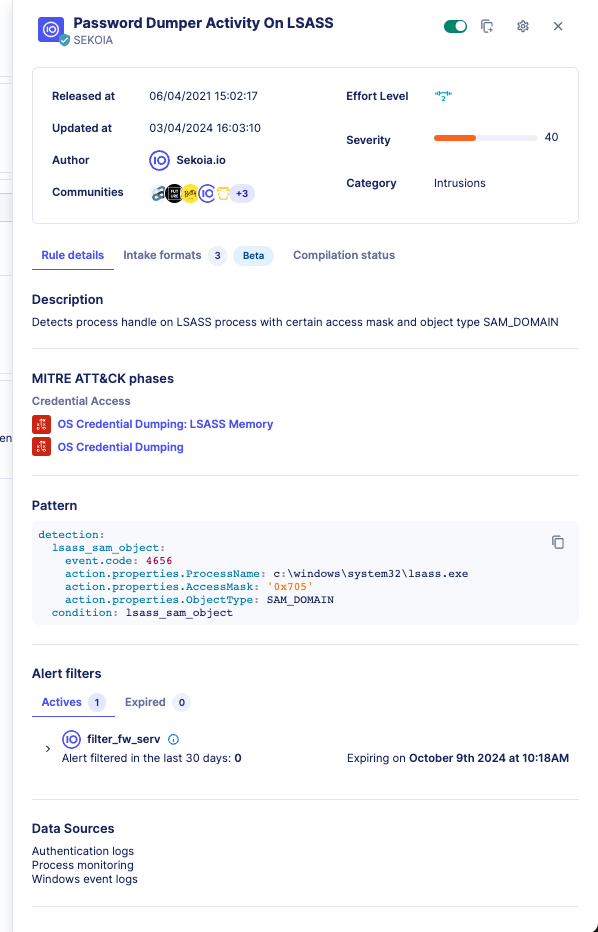
Compatible intake formats
This section list the compatible intake formats you can use with the detection rule. Configuring one of these intake formats allow the detection rule to receive compatible events to perform detection.
In the list, the configured badge indicates intake formats that are already configured. You can click on the configured intake to go the intake page.
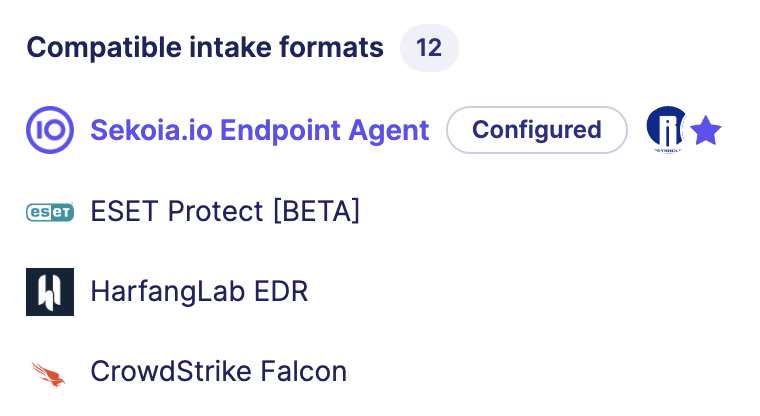
Tip
You can use this feature to run simulations with the MITRE matrix to improve your security posture. Select a new intake to have a preview of the techniques that will be covered by configuring this datasource.
Alert filters
In the section Alert filters, you can consult the list of alert filters that are currently enabled in the Actives tab. The number of alert muted in the last 30 days is displayed for each alert filter to help you audit its effectiveness.
Click on the arrow to expand the alert filter and consult the exclusion pattern.
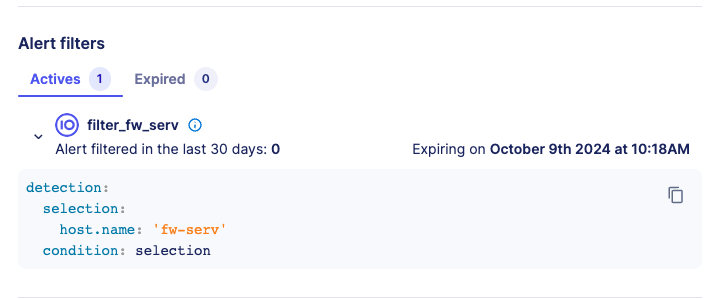
The Expired tab list all the alert filters that had an expiration date set and whose date has been reached. Expired alert filters can be deleted if needed.
Rules with active alert filter
To search for rules that have at least one active alert filter, use the search Alert filter and select the criteria Rules with alert filters.
All rules with active alert filters will be returned in the list.

You can also search for rules that have no active alert filters with the other search criteria.
Enable new rules
Automatically
New verified rules are created regularly. You may not want to look at the rules catalog daily to decide if you want to enable them or not. By clicking on the configure icon at the top right of the Rules Catalog page, you can configure which rules should be automatically enabled for your organization.
Rules are automatically enabled based on the configured effort level, or you can decide to never automatically enable rules.
Manually
To ensure that activated rules comply with your security policy, you can choose which rules you want to enable. For an MSSP Community, you can easily enable your custom and verified rules in multiple managed communities.
Enable / Disable all rules
As seen previously, rules can be filtered by type, status, effort level and tags. To enable or disable these filtered rules, you can simply click on the button Enable all or Disable all that are displayed under the search bar.
Create custom rules
In addition to the verified rules that are already built-in, you can create your own rules to support other detection use cases. To create a rule, click on the + Rule button at the top right of the page and fill out the form.
The Rule creation form has the following sections:
Rule testing
The Sigma Pattern Testing feature allows SOC analysts to validate detection rules against historical data before production deployment, reducing alert noise and improving detection accuracy. This capability addresses critical operational challenges by enabling thorough rule validation without disrupting production.
Testing overview
Warning
Detection rules with Sigma Correlation are not supported for testing. Only Sigma rules are supported by the pattern testing feature.
Correlation rules are fundamentally different from simple detection rules. While simple rules evaluate individual events in isolation, correlation rules must identify relationships and patterns across multiple events such as detecting a sequence of failed login attempts followed by a successful login or identifying suspicious activity patterns across different data sources within a specific timeframe.
These advanced capabilities go beyond the scope of standard event search.
Warning
Detection rules with Time-based detection are not supported for testing and will not be supported in the future.
Time-based detection uses modifiers such as timerange, day_of_week, day_of_year, and public_holiday_in to detect events during specific time periods. These temporal filters require infrastructure capabilities that are not natively supported by our search architecture. Supporting this feature would require full data scans that significantly impact performance. To ensure long-term platform stability and performance, we have chosen not to implement this functionality in pattern testing.
For more information about time-based detection in Sigma rules, see the Sigma documentation.
Pattern testing provides two distinct testing modes:
- Rule Testing: Validate new or existing Sigma detection patterns against historical event data
- Alert Filter Testing: Test alert exclusion patterns to optimize filtering and reduce false positives
Both testing modes help prevent non-relevant alerts, increase detection accuracy, and enable rule threshold tuning in a controlled environment.
When to use pattern testing
Use pattern testing in the following scenarios:
- Before deploying new Sigma rules
- When optimizing existing detection rules
- Before implementing alert filters for noise reduction
- When analyzing rule performance over different time periods
Rule testing
Rule testing allows you to evaluate how a Sigma pattern performs against historical data, providing insights into detection frequency and event distribution patterns.
Accessing rule testing
- Navigate to the Rules Catalog page
- Create a new rule
- Click the Test pattern button to open the testing modal
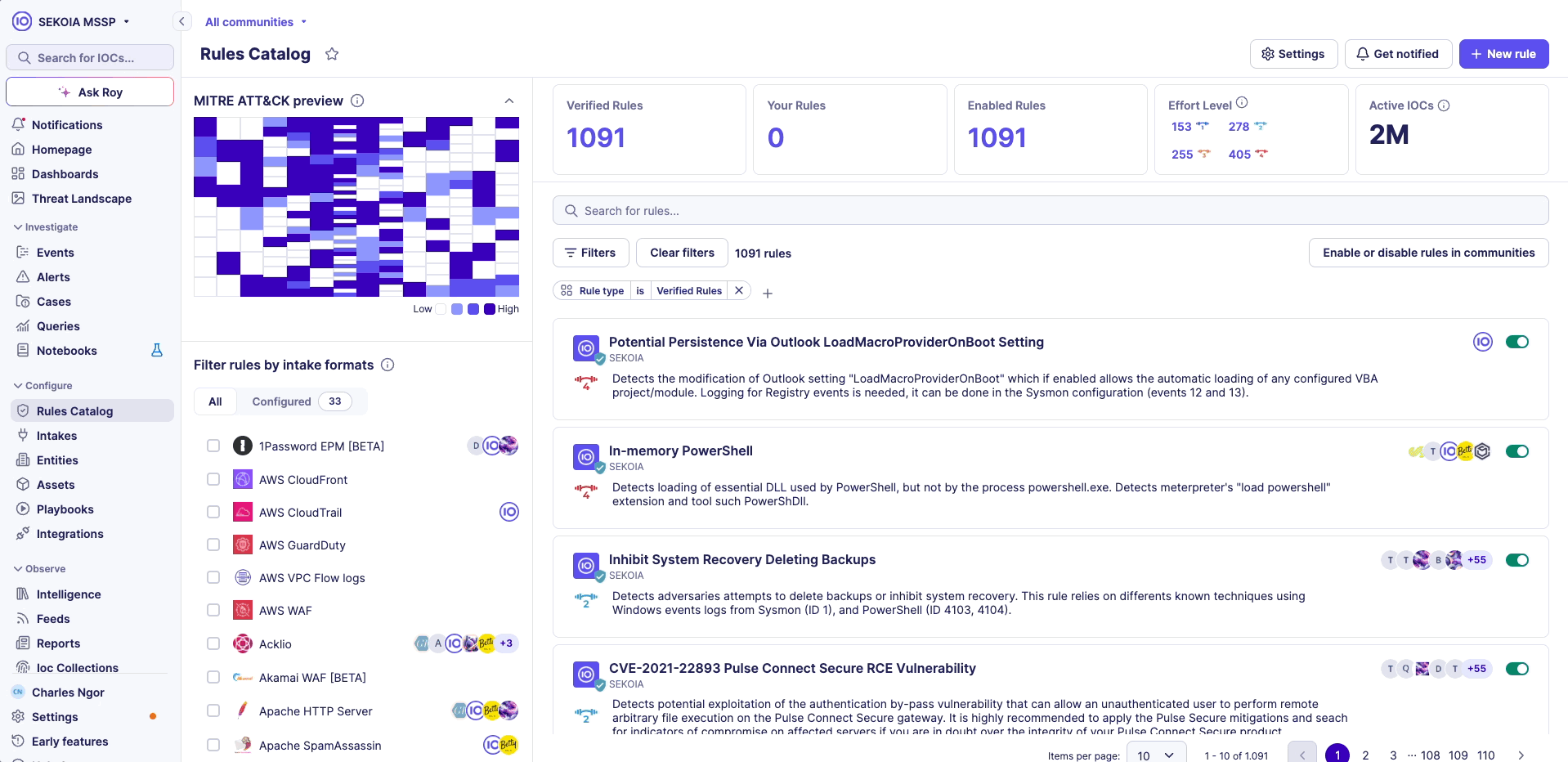
Testing interface
The testing modal displays the following components:
- Sigma pattern: The detection pattern to be tested
- Time range selector: Choose from 7, 30, or 60 days of historical data
- Test pattern button: Launches the pattern testing process
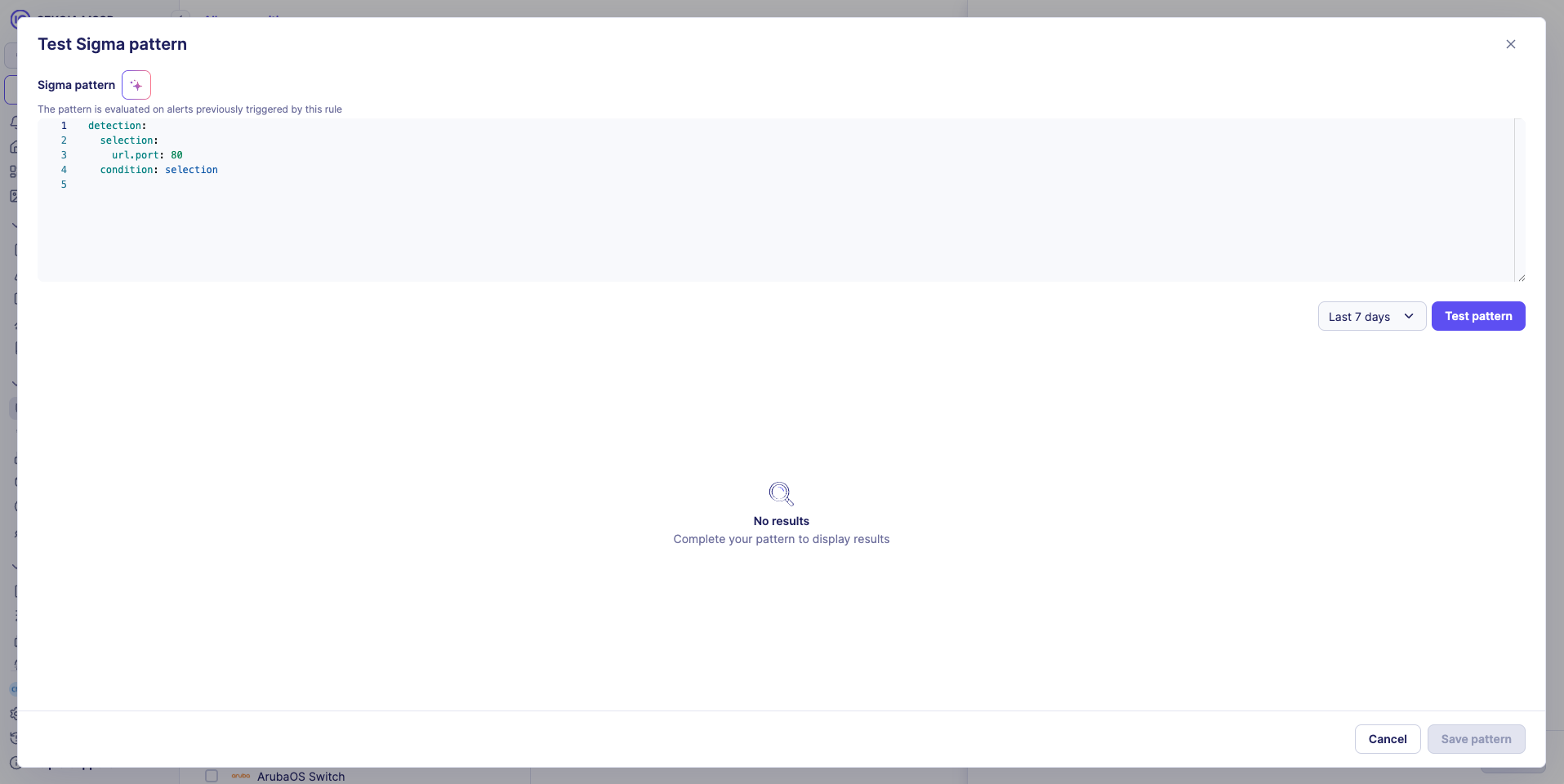
Running a test
- Select time range: Choose the historical data period (7, 30, or 60 days)
- Review pattern: Verify the Sigma pattern is correct
- Launch test: Click Test pattern to begin testing
- Analyze results: Review the dual visualization output
Test results visualization
Test results are presented in two complementary formats:
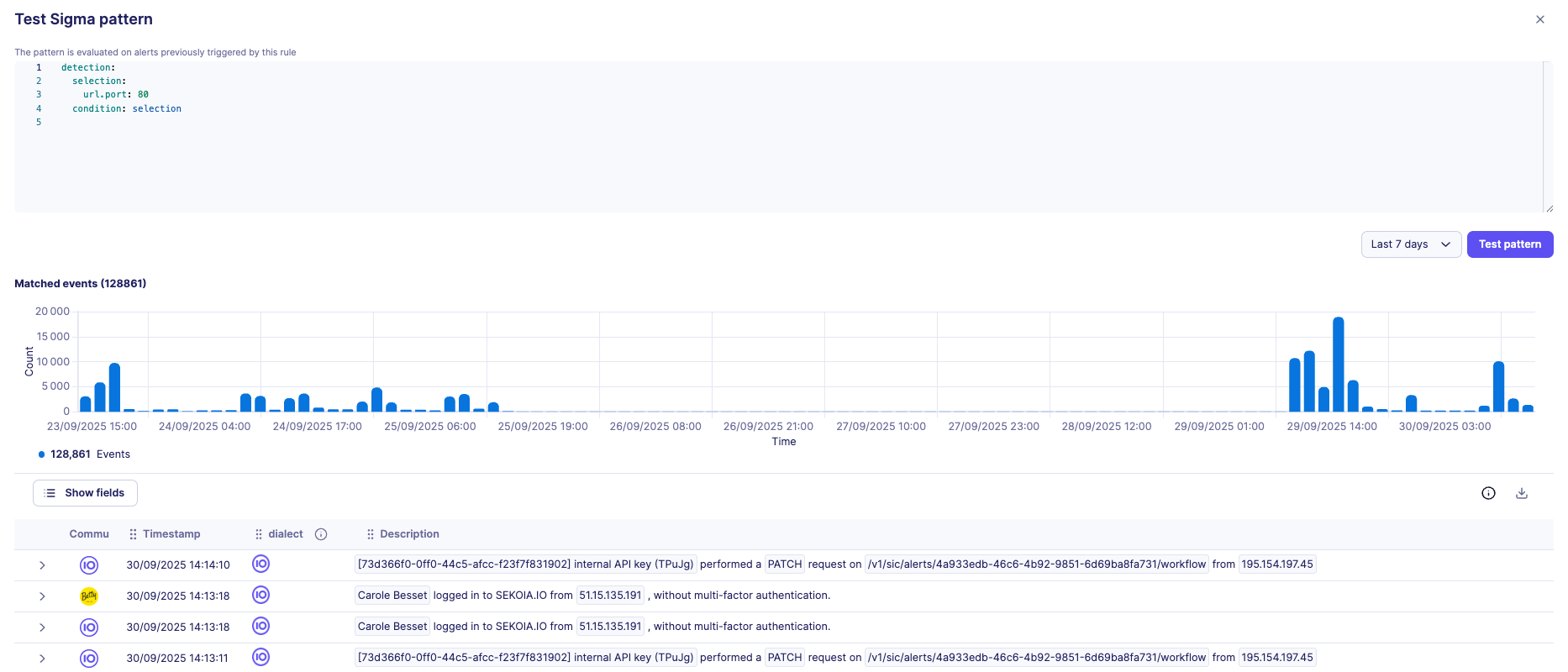
1. Chronological bar graph
- Displays event distribution over time period
- Helps identify temporal patterns and detection frequency
- Useful for understanding rule behavior across different time periods
- Shows number of matched events
2. Detailed event list
- Provides drill-down access to individual matching events
- Show fields component to select relevant event properties to display
- Show more button for progressive loading of additional results
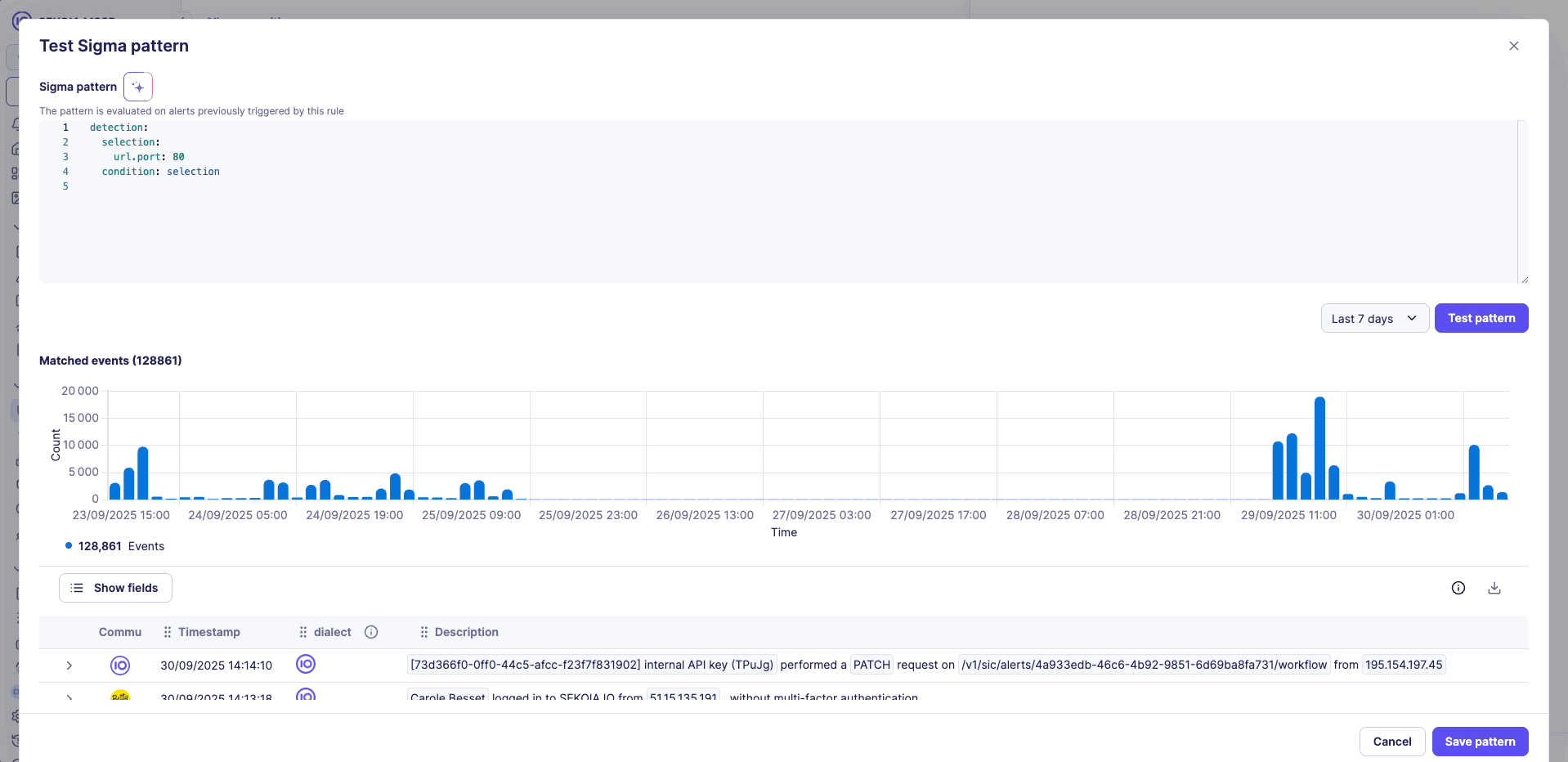
3. Event property analysis
- Top 10 value distribution analysis for each event property
- Percentage-based breakdown of property values
- Helps identify patterns and potential tuning opportunities
Interpreting results
- High event count: May indicate overly broad detection criteria
- Temporal clustering: Events concentrated in specific time periods may suggest targeted attacks or system behavior
- Property distribution: Uneven distribution may indicate opportunities for rule refinement
Alert filter testing
Alert filter testing provides enhanced capabilities for validating exclusion patterns, with additional context about existing alerts and their relationship to the filter being tested.
Enhanced testing interface
Alert filter testing includes all rule testing components plus:
Alert correlation table
- Lists existing alerts related to the same detection rule
- Visual indicator highlights the current alert context
- Displays alert metadata: ID, rule name, creation date, and status
- Matches filter: Boolean indicator showing whether the pattern fully excludes the alert. Helps verify filter effectiveness and coverage

Alert filter testing process
- Access filter testing: Click Test pattern when creating an alert filter
- Review alert context: Examine the alert correlation table to understand current alert landscape
- Configure filter pattern: Define or modify the exclusion pattern
- Select view mode: Use segmented control to toggle between:
- Matching events: Events that match the filter pattern (will be excluded)
- Non-matching events: Events that don't match the filter pattern (will still generate alerts)
- Analyze coverage: Review both matching and non-matching events to ensure proper filter scope
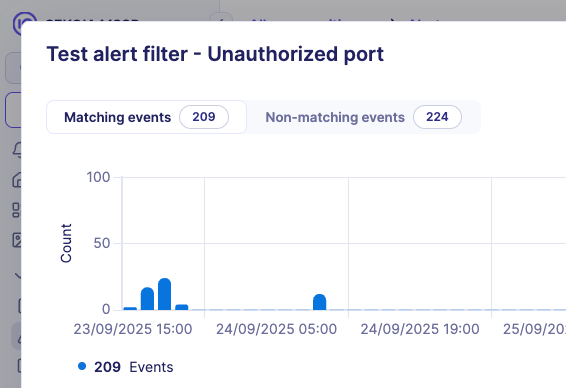
Alert filter testing best practices
Pattern refinement
- Review non-matching events to identify gaps in filter coverage
- Adjust filter patterns to achieve desired exclusion scope
- Balance between noise reduction and detection sensitivity
Validation workflow
- Test with Matching events view to confirm intended exclusions
- Switch to Non-matching events view to verify legitimate alerts remain
- Iterate pattern adjustments based on both views
- Validate filter effectiveness using the Matches filter indicator
Testing best practices
Pattern development
- Start with broader patterns and refine based on test results
- Use multiple time ranges to validate pattern consistency
- Consider seasonal or business cycle impacts on detection patterns
Performance considerations
- Longer time ranges provide more comprehensive data but take longer to process
- Focus on recent time periods (7-30 days) for current threat landscape validation
- Use 60-day ranges for comprehensive historical analysis
Threshold tuning
- Analyze event frequency to set appropriate detection thresholds
- Consider normal business operations when setting alert frequency expectations
- Use temporal patterns to identify optimal detection windows
This comprehensive testing framework ensures detection rules are thoroughly validated before production deployment, maintaining high detection accuracy while minimizing operational disruption.
General definition of the rule
- The rule name is mandatory during the creation, it will be used to name the corresponding raised alerts by default. You can add an optional description below.
- Select the effort level required and the threats detected with this rule if any, by selecting it from the MITRE ATT&CK or by using the search bar through keywords or the drop-down list.
- For an MSSP community, first select the community you want to create your rule in.
Two options are available: select All communities or select a specific community.
If you choose All communities, your rule will be available for all your communities and you can enable it later on the desired community.

Detection Pattern
This is the detection logic itself. It varies according to the selected rule type.
Note
Fields available to create a detection pattern follow the ECS standard and can be found on Events page > Show fields and top values.
Security alerts
In the Alert properties part, you should indicate the category and type of the alerts raised by the rule and the severity of the rule, which is used to calculate the urgency of the corresponding raised alerts in association with assets criticality for events matching assets.
Fields displayed in alert events
You can select fields that will be displayed in events present inside your raised alerts to speed up alert qualification.
To search for fields you want to display, click on the select and type in your event field. This field works as an auto-complete.
Custom similarity strategy
Alerts are considered similar when some event fields have identical values.
You can select these event fields in your rule configuration. To do so, click on the select and type in your event field. You can select as many fields as needed.
In addition to that, these event fields can be added to the Swappable fields. A typical example of that is source.ip and destination.ip.
Warning
Custom similarity strategy are not supported with Sigma Correlation rules.
Fields used in the group-by clause of the pattern will be used as similarity strategy.
Note
You can learn more about similarity strategies in this section.
Edit your custom rules
When the Rule Details panel is open, you can click on the Configure icon at the top right to edit the rule's configuration.
For Custom rule, you will be able to edit its main definition:
- General definition of the rule
- Validity date
- Detection Pattern
- Security alerts (event fields can be selected to define the similarity strategy in the section
Similarity strategy).
For an MSSP communty, when you edit this part and your rule is multi-communities, changes will be shared with all your managed communities.
Limiting the scope of a rule
For all types of rules, You will be able to limit its applicable scope with the following filters. For an MSSP community, these filters will be applied only on the community selected:
- Alert Filters: are additional patterns that you can add to any rule to exclude matching events. This is useful to exclude known false positives so that your detections are always spot on. It is often easier to create Alert Filters directly from an Alert.
- Entities: select the entities this rule should apply to. By default, rules apply to all entities.
- Assets: select the assets this rule should apply to. By default, rules apply to all assets

When rules have limited scope with selected entities or assets, these rules will not automatically apply to new entities or assets that are later created.
Create an alert Filter
To prevent known false positives from raising alerts in the future:
- Click on the
+ Alert filterbutton to create an alert filter - Enter the
nameof the alert filter (mandatory) - Enter the
descriptionof the alert filter (optional) - Enter the
patternto exclude events (mandatory) - Set an
expiration date(optional) to define a temporary alert filter
Notify on new rules
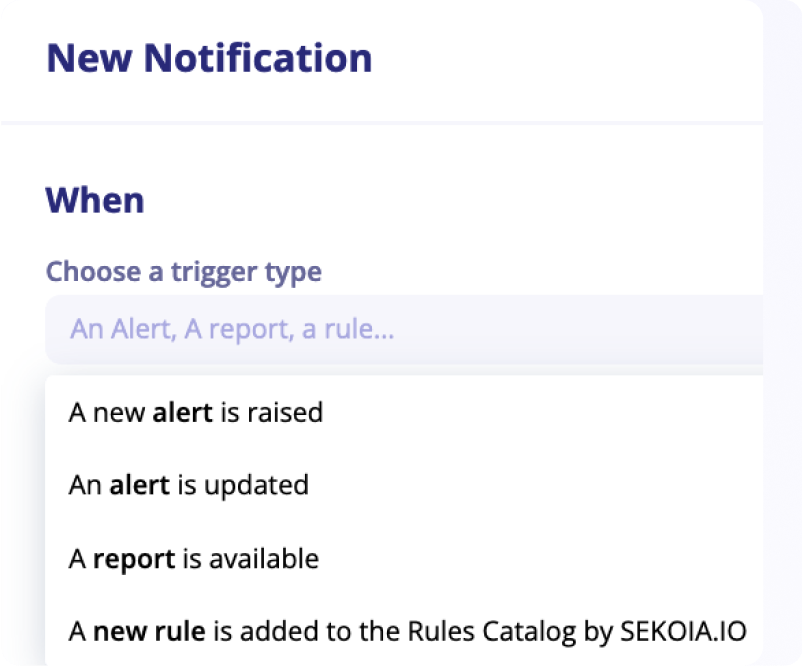
We continuously update the rules catalog with new rules.
To keep posted, we introduced a dedicated trigger in the Notification Center. This new notification trigger enables the creation of notification rules that triggers when a new detection rule is added to the Rules Catalog by Sekoia.io.
This trigger supports additional filters on the name of the detection rule, its description, pattern or severity.